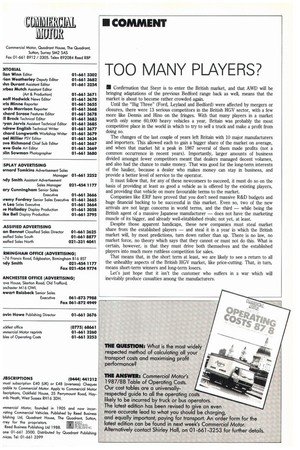TOO MANY PLAYERS?
Page 5

If you've noticed an error in this article please click here to report it so we can fix it.
• Confirmation that Steyr is to enter the British market, and that AWD will be bringing adaptations of the previous Bedford range back as well, means that the market is about to become rather crowded again.
Until the "Big Three" (Ford, Leyland and Bedford) were affected by mergers or closures, there were 13 serious competitors in the British HGV sector, with a few more like Dennis and Hino on the fringes. With that many players in a market worth only some 60,000 heavy vehicles a year, Britain was probably the most competitive place in the world in which to try to sell a truck and make a profit from doing so.
The changes of the last couple of years left Britain with 10 major manufacturers and importers. This allowed each to gain a bigger share of the market on average, and when that market hit a peak in 1987 several of them made profits (not a common occurrence in recent years). Importantly, larger amounts of business divided amongst fewer competitors meant that dealers managed decent volumes, and also had the chance to make money. That was good for the long-term interests of the haulier, because a dealer who makes money can stay in business, and provide a better level of service to the operator.
It must follow that, for any of these newcomers to succeed, it must do so on the basis of providing at least as good a vehicle as is offered by the existing players, and providing that vehicle on more favourable terms to the market.
Companies like ERF have proved that you don't need massive R&D budgets and huge financial backing to be successful in this market. Even so, two of the new arrivals are not large concerns in world terms, and the third — while being the British agent of a massive Japanese manufacturer — does not have the marketing muscle of its bigger, and already well-established rivals; not yet, at least.
Despite those apparent handicaps, these new companies must steal market share from the established players — and steal it in a year in which the British market will, by most predictions, turn down rather than up. There is no law, no market force, no theory which says that they cannot or must not do this. What is certain, however, is that they must drive both themselves and the established players into much more ruthless competition for sales.
That means that, in the short term at least, we are likely to see a return to all the unhealthy aspects of the British HGV market, like price-cutting. That, in turn, means short-term winners and long-term losers.
Let's just hope that it isn't the customer who suffers in a war which will inevitably produce casualties among the manufacturers.




















































































































